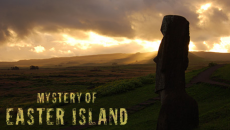
Easter Island is a remote piece of land more than 2,180 miles away from the mainland (Chile in South America) and 1,289 miles away from the nearest piece of inhabited land. Despite its remoteness a tribal people called the Rapa Nui prospered on it and it is thought that these people were Polynesians who sailed to the Island around the year 1200 AD (that’s over 800 years ago!). The people thrived on the island with the fertile soil, growing crops and living there for several hundreds of years during which they sculpted the great Moai stone heads which are thought to have been constructed in honour of their Gods. However they began to chop down the palms and woodland on the island for buildings and canoes and tools and it is commonly thought that once the final tree had been used the people could no longer fish or farm effectively. Also with the removal of the trees much of the fertile land was also washed away and so even with tools therefore the island’s inhabitants could either starve or resort to cannibalism.
Scientists believed that the civilisation was reduced from a thriving 20,000 to some starving 3,000 people by the time the Dutch arrived in 1700 and that the Rapa Nui’s legacy had all been washed away or scavenged in a fight for survival with the great stone heads of the Moai statues the only remaining icon of their once thriving civilisation. However a group of leading U.S scientists have new evidence to counter this, stating that the concept of the civilization’s collapse due to deforestation is actually false. In fact it seems that the indigenous people were wiped out by the arrival of Europeans who brought with them diseases that the indigenous tribes could not cure and also slavery which destroyed the civilization. Archaeological evidence suggests that the island’s inhabitants survived perfectly well after all the trees were removed and fashioned new tools made of other materials that allowed them to continue to prosper. It appears that instead of a sudden abandonment of all rational thought when the wood was used up the decline of farming on Easter Island was in fact a gradual process and correlates with the timing of the arrival of Europeans who employed their own methods and ruined the livelihoods of this ancient civilisation.
What do you think really happened to the people who built these great stones? Ultimately it is one of history’s great mysteries as we have no records but those of the Dutch colonialists and it would have reflected badly on them from a moral perspective to say that they destroyed a civilisation so they might have lied in their records just as so many conquerors have done in history. We can never know but this new research has paid tribute to the descendants of the Rapa Nui tribe who live on the island today. Regarless the truth that lies behind the story, the great stone Moai heads continue to stand ominously and yet inspiringly as a testimony to the ancient Rapa Nui tribe that prospered once on that island in the Pacific so far from the mainland.
IMAGE: http://www-tc.pbs.org/wgbh/nova/assets/img/posters/mystery-easter-island-vi.jpg

0 Comment:
Be the first one to comment on this article.